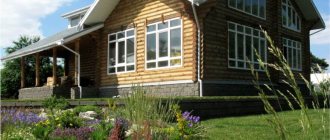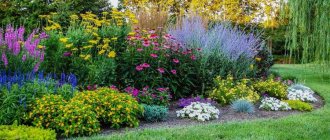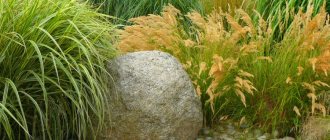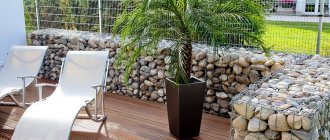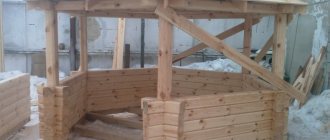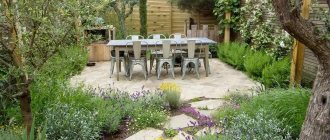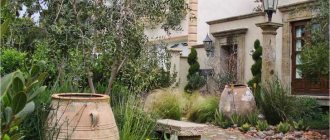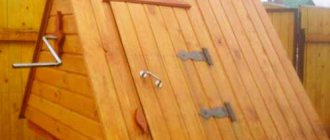Having free space on the site is an excellent opportunity to diversify the landscape by adding an unusual flower bed made of crushed stone or gravel. Such a flower garden will not cause problems during the maintenance process and will become an effective element of decor; it can be decorated exactly the way you want, thanks to the convenience of the source material. A do-it-yourself crushed stone flowerbed is an excellent option even for inexperienced gardeners. Everyone can create a real work of landscape art by showing their imagination.
Advantages and disadvantages
Advantages of vertical flower designs:
- Easy to care for plants . Absence of weeds and small pests, so there is no need for digging;
- Take up little space . This is especially true for growing in a small area of land, a garden, or even in an apartment building;
- Ease of construction of structures . Freedom of creativity and imagination - when you can build foundations for flower beds with your own hands;
- Versatility and mobility of flower beds . Want to move it to another corner of the garden? Almost all vertical flower beds are lightweight, they can be supplemented, modules can be moved;
- External attractiveness . Vertically planted flowers highlight a summer cottage and become its unique decor.
An excellent combination of palette in choosing planting annuals.
There are also disadvantages, these include:
- Unsuitable for winter . If perennial plants are grown, then the soil freezes in the cold season, the beds will have to be covered in a greenhouse or in a heated room;
- Small volume of soil . For a vertical flower garden and a garden flower bed, flowerpots of a certain size are required. Limiting containers is not suitable for all types of green crops, but those already planted will require additional feeding;
- Lack of moisture . A cascading flower bed needs frequent watering, because the soil in vertical containers dries out much faster than in a vegetable garden.
Flower pots attached to the fence wall decorate the garden.
To correct deficiencies, they will help you:
- Hydrogel . An artificial material based on polyacrylamide that accumulates moisture in the soil. As a result, ideal living conditions for plants are created;
- Automated drip irrigation system . You can buy it at a specialty store or make it yourself. In this case, you will need a pipe whose diameter will not exceed 3 cm; small holes are drilled in it, using a third of the entire pipe. The diameter of the holes is approximately 5 mm.
Variety of flowers in flowerpots in the courtyard
Build process
To make it, you need to fold the mesh into the shape of a pot or container and secure it with wire or clamps. The inside is covered with a dark film. The resulting pipe is inserted into the pot and covered with soil. Small holes should be made in the film in the places where the plants will be planted.
After planting the seedlings, water the finished flower bed. To make watering more uniform, you can insert a plastic pipe with small holes into the middle of the flowerbed. The finished flowerbed will look great and will emphasize the sophistication of the area’s design.
Types of vertical flower beds
Today, manufacturers offer us ready-made solutions: flower beds made from different materials for planting vertical plants. They consist of about 10 tiers, there is even a watering system installed for safe and easy care of the plantings. The cost is not budgetary, so you can make the structures yourself. Let's consider all the options for flower beds for vertical gardening.
flower tower
The tower is a wooden or iron beam with hooks on which flower pots and vases with flowers are hung.
An imitation of the original flower tower will decorate the garden.
Flower ball
The base of the ball is made of wire, connecting circles. At the same time, they leave free space for plants. The distance for seedlings should be at least 6 cm from each other. A polyethylene bag is placed in the ball, filled with soil, holes are made and seedlings are planted. It is advisable not to hang the ball directly under the sun.
You can also make a hanging ball for growing flowers yourself.
Screen
The screen looks like a bright cascading stand, supported by a support. Pots with plants are hung on hooks or placed on already attached shelves.
The combination of wood and a row of flowers on the facade complements the space outside.
Blooming pillar
A cylindrical container is filled with soil. Holes are made at different distances from each other and green crops are planted.
Bright flowers against the background of beige walls decorate the entrance of the house.
Tunnel
The flower corridor is formed from a series of colorful arches.
A tunnel of bright, precisely planted plants creates a fabulous impression.
How to create a vertical flower bed with your own hands is shown in the video below
Hanging flowerpots
The easiest way to decorate your garden plot. Flowerpots are mounted on walls, fences and hedges, on any vertical, stable base. The main advantage is that there is no need to follow strict rules of landscape design. Any height and all colors can be combined with each other!
The geometric shapes of flower beds look catchy.
To learn how to properly create a flowerbed design without outside help, read the article: Design of a flowerbed with stones.
Posting rules
When creating a flowerbed, you should adhere to several recommendations. They will help make the design harmonious.
- You should not chase the abundance of species and number of plants. An overloaded flower bed looks sloppy, and flowers that are planted in vertical structures suffer from a deficiency of minerals and water. When planting plants, you need to make gaps of 5-7 cm between them.
- Three to five plant species for one “tower” is optimal.
- The colors of the buds should be combined and in harmony with each other, in addition, you need to think about whether the plants will bloom at the same time or replace each other.
- Gaps and voids can be disguised with the help of decorative elements, greenery, and grass.
- It is necessary to give preference to plant species with a shallow root system; they will do well in a limited space.
How to make a vertical flowerbed using improvised materials
You can come up with an original cascading vertical flowerbed yourself. Absolutely all available materials lying around in the utility room are suitable for production: buckets, plastic bottles, baskets, barrels, boards.
From plastic bottles
Don’t rush to throw away used bottles. They will perfectly replace pots and flowerpots in the process of vertical garden design. As a result: you get a blooming screen. It can be made from a wooden flat board, up to 2 m high. Homemade flowerpots made from bottles are attached to the surface.
Preparation method:
- cut the bottle into equal parts, we get 2 pots;
- or cut off the bottom or neck, we get 1 large container;
- make a hole in the side;
- We attach the vases to a wooden background at a distance from each other;
- We fill the bottles with soil and plant vegetation in them.
After some time, the entire shield will literally bloom and look bright. This method is also suitable for decorating the walls of a house, barn, or gazebo. If we are dealing with a brick wall, then in order to avoid the spread of dampness, the vases are attached to hooks.
An unusual wall of reinforced bottles on a fence with flowers cannot get boring.
From the boxes
Boxes made of plastic or wood are another replacement for full-fledged pots.
Preparation method:
- fill 5 boxes with soil and install them;
- It’s best not to stack them on top of each other, but scatter them, leaving gaps;
- into the gaps and plant green crops.
As the flowers grow, they will hide the boxes with their array of greenery.
Wooden boxes with flowers create a feeling of unity with the garden and nature.
Made from metal mesh, chain-link mesh and garden film
A labor-intensive but practical way of landscaping a site.
Preparation method:
- we purchase a piece of mesh where the length and width are approximately 1 m;
- We lay a net, and on top - a dense dark-colored garden film. We connect the mesh and film with staples along the edges;
- We roll the mesh with the film into a tube so that the side with the film is inside the cylinder. We make holes in the film;
- secure it in a container (pot, bucket, vase). For a chain-link mesh, you will need a container of wide diameter, since the mesh is more voluminous;
- pour expanded clay onto the bottom in a layer of up to 10 cm;
- take a corrugated tube about 15 cm in diameter, make small holes along the entire length, seal one side with tape, insert the taped side into the cylinder;
- fill the free space between the tube and the mesh with soil;
- fill the tube with water;
- We plant the plants in the prepared holes; you can also plant flowers on the upper plane for decoration.
A flower bed made of dark-colored film provides the necessary, comfortable environment for flowers.
Important! A homemade drip irrigation system provides the necessary nutrition to plant roots. To prevent the water from evaporating too quickly, place a small piece of slate on the very edge.
From geotextile
Flowerbeds are also created using durable, moisture-permeable fabric.
Preparation method:
- we take several pieces of reinforcement up to 2 m long, strengthen them into the ground so that we get a circle;
- we wrap the segments with geotextile several times, forming a cylindrical vase along the way;
- we make mini-cuts on the canvas for future flowers;
- install a corrugated pipe for the irrigation system as described above;
- fill the space left free between the material and the tube with soil;
- Place the seedlings in the soil next to the holes.
A budget-friendly and durable option for arranging flower beds in a summer cottage.
Important! Choose geotextiles and film in a dark color. Experts recommend this so that light does not leak into the nutrient medium and flowering and wilting of the root system do not begin.
From a pallet
A whole wooden pallet is sanded to a smooth state, treated with a special anti-rotting agent, and varnish or paint is applied.
Preparation method:
- We fold the geotextile in several layers and attach it using a furniture stapler to the inside of the pallet. The tray must be closed on all sides except the front part;
- Place the pallet on the surface with the inside facing up and pour soil into the holes between the boards. Shaking the container periodically and adding soil;
- here, in the holes, we plant the prepared flowers and water the seedlings;
- we leave the flowerbed in this position for several days, then we lift it vertically and install it where we planned, for example, near a fence or the wall of a house.
Flower beds planted in the holes of the pallet take up little space on the ground.
Using other items
If you have old, ownerless items, do not rush to say goodbye to them. Watering cans, buckets, pipes, wheels, tires, boxes - anything will do.
Watering cans, buckets, basins
Preparation method:
- we dig a pipe into the ground and attach containers for plants in it;
- We fill them with soil and plant flowers. Don't forget to water.
A practical way to reuse household items is to create beds and flower beds in them.
Tires and Tires
Preparation method:
- we install old tires, simulating a pyramid;
- fill the soil and plant plants around the perimeter.
Painted in bright colors, the tires transform any area.
Plastic pipe
A flower garden from a profile pipe is prepared with your own hands in the following way:
- we make holes in the pipe about 6 cm in diameter at different heights;
- fix the pipe into the ground and fill it with soil;
- Let's plant flowers in the holes.
A vertical flower bed made of PVC pipe is a convenient and practical way of landscaping an area.
Important! To organize drip irrigation, use a tube as described above.
Pots and containers
Preparation method:
- install containers on a wall or fence;
- fill it with soil and plant flowers.
The option of placing flowers in pots for a vertical garden is ideal in a small space.
Barrels and containers
Preparation method:
- cut off the bottom on one side and make holes in the sides of the barrel, at a distance of at least 20 cm from each other;
- install the irrigation pipe in the manner described above;
- fill the voids with soil and plant flowers in the holes and on top of the barrel.
A flowerbed in a durable wooden barrel does not take up much space in the garden.
How to create a mini-greenhouse at home , read the article: Flower arrangement in the interior.
Blooming pillar at home
You can make a beautiful flower bed like a flowering column with your own hands, using plastic mesh and geotextiles (can be replaced with film). Step-by-step production of designs for flowers:
- 4-5 pegs are driven into the ground at the selected site to a sufficient depth (to securely fix the structure).
- A film is wrapped around the resulting frame, and the structure is reinforced with mesh from the outside.
- Soil is poured inside the resulting tower, alternating soil with expanded clay (drainage layer).
- Several holes are made along the surface of the film with a knife.
Flowers are planted in the holes, usually annual crops (petunias are perfect for a vertical flower bed).
How to choose suitable flowers for vertical flower beds
For vertical flower beds, garden and landscape designers recommend choosing bright, unpretentious annual plants. Annual flowers will not delight you for so long, but they compensate for the short flowering period with a limitless palette of shades.
A harmonious combination of different varieties of flowers complements the balcony.
The most suitable types:
- Petunia . The most popular plant. A long-flowering species, it pleases before the onset of cold weather, but loves the sun and warmth;
The most suitable species: petunia. The most popular plant. A long-flowering species, it pleases before the onset of cold weather, but loves the sun and warmth;
- Nemesia. Multicolored nemesia will bloom a month after planting;
Lush-flowering nemesia is an excellent option for diversifying flower beds.
- Lobelia . This flower has a variety of shades of blue: from pale blue to deep purple;
Gracefully blooming lobelia abundantly covers the flowerbed.
- Godetia . Resistant to adverse weather conditions, godetia blooms from mid-summer until the first frost;
Matching shades of godetia flowers for a vertical flower bed
- Sweet pea . Large flowers, up to 5 cm, form a bright head in a flowerpot. Loves abundant watering, sunlight and is resistant to bad weather;
Sweet peas will fit perfectly into your garden
- Mirabilis . A nocturnal flower that blooms its buds exclusively in the evening, and during the day it rests, hiding them. Resistant to heat and drought;
Sunny mirabilis will decorate any garden bed
- Nasturtium . Curly stems with bright buds love sun and moisture at the same time.
Bright nasturtiums beautifully woven into the fence
Build process
Smaller diameter holes are made in the smaller pipe. The prepared pipe is wrapped in burlap or any other non-woven material. The bottom is sealed with tape or foil.
Holes are made in the larger pipe. Seedlings will be planted there. The bottom also needs to be securely closed. The larger pipe should be fixed in a vertical position and the smaller one should be inserted inside. The pipe is covered with prepared soil.
To avoid the formation of voids, it is necessary to plant plants after several days of regular watering.
Types of design solutions
If you plan to make your plot original, then you need to take a responsible approach to landscape design.
It is important not only to select high-quality material, but also to plan the desired composition and combine several flower beds into a whole ensemble.
An ordinary composition designed using this material has clear shapes and boundaries. In production, a border is used, which is laid out with cobblestones in one or several layers.
Gabions are distinguished by the use of a two-layer metal mesh as a frame. The composition of the desired fraction is poured into it. Thanks to this, the structure receives additional stability, as well as improved drainage.
It will be very interesting to decorate a flower bed with natural or artificial stones if you choose a rock garden. To do this, you need to select cobblestones that belong to the same breed, but have different sizes.
- Indoor ventilation
Choosing grass for the lawn
Deutzia is blooming - summer is coming
Limestone or slate will look good in the design. Large cobblestones should be buried, and small ones should be scattered over the area. You can plant low-growing shrubs or creeping plants in the ground.
For an alpine hill, mountain plants with strong roots should be planted. The material used is cobblestones laid out in a multi-stage structure. But a raised flower bed will allow you to decorate an area with poor soil. Creating a multi-tier structure significantly saves space.
The qualitative transformation of the area in the garden can be seen in the photo of a flower bed made of stones laid out in the form of a terrace. The material used is quartz, basalt or granite, which have increased strength. And limestone and sandstone will help create a mountain look.
If you take rounded elements and place them pointwise over an area, you will get a beautiful Japanese garden. They are covered with moss, and a variety of plants can be planted between them. Pebbles should be carefully laid out on the ground, and a small fence should be installed around the perimeter.
Arabesque
This type of stone flower beds is used quite rarely. This is due to the fact that the design of this flower bed is quite formal and suitable for decorating any government buildings.
The arabesque itself looks like a large canvas on which flowers are located. In addition, you can use your imagination and plant flowers so that they are arranged in a pattern.
Let us remind you that this method is one of the most expensive, since the canvas itself is quite large and you will have to plant a lot of flowers.
Evergreens - a complete list with descriptions and recommendations from a gardenerVertical gardening - from idea to implementation, choosing options according to budget and attractiveness (photo + video)
- Vertical flower beds - basic principles and rules for choosing plants and arranging a suburban area with your own hands
In addition to the fact that planting flowers will take a lot of money, they are also very difficult to care for. They only need to be watered using a special hose with a special spray nozzle.
Considering that this method has quite a lot of inconveniences, it also has a plus. The main advantage of this method is that it looks incredibly beautiful and large-scale.
To summarize, this method of laying flower beds is only suitable if you have a fairly large dacha and have a lot of time and money.
But, if you have a rather small dacha area, then it is better to pay attention to other types of stone flower beds.
Construction of a flower garden with a border
To build a fence, it is necessary to dig a trench around the perimeter for the foundation. Its depth can be 250-300 mm. The specific dimensions of the recess depend on the size of the boulders that will be placed in it. Find out more about the compost bin here.
The bottom of the trench should be lined with roofing material or polyethylene. A sand cushion is poured on top. Although for a structure made of small particles this step can be skipped.
Ruberoid is poured with a layer of cement, and sand is placed on top of it on a third of the ditch and compacted well. After the concrete base has hardened, first large blocks are installed on the sand layer, and then smaller ones. The gaps between them are filled with a mixture of concrete.
Additives from crushed stone and gravel will add greater strength to the structure. If you leave several holes along the lower level, you will improve ventilation in the structure.
The ground part of the frame should have a slight inward slope. For its arrangement, smooth cobblestones are used. In order not to spoil the appearance of the masonry, the cracks are sealed with mortar from the inside. The top layer of soil must be removed from the surface, drainage laid and covered with fertile soil. Plants are planted 2-3 days after the soil settles.
The brick border is made in a similar way. The ditch is first filled with sand, then with a layer of crushed stone or gravel. Bricks are laid on top, but are not fastened with mortar, allowing excess water to freely escape beyond.
What is colored stone chips
Crushed stone is a derivative of crushing rock blocks. This is an inorganic bulk material of various grain sizes with a fraction of 5 mm. The crushed future decorative chips are sifted and sorted by size. In other words, this is waste from quarries where mining is carried out:
- granite;
- limestones;
- marble.
Decorative stones are also obtained from the processing of metal ores. Depending on the waste material the crushed stone is, its quality characteristics also appear. It can vary in strength, shape, and color.
Colored crushed stone
Crushed stone, formed naturally, during the natural decay of mountain structures, having the shape of rounded grains and a smooth surface, is called gravel. If the pebbles have been on the seashore for a long time and have acquired rounded shapes, they are called pebbles.
Colored pebbles
The natural color of the material is determined by its origin. Crushed stone is found:
- white;
- all shades of gray;
- red-brown;
- pinkish beige.
The last two options are derivatives of granite and marble.
Tools
To make a vertical flower bed, you need to prepare the following materials and tools:
- plastic container of suitable volume;
- polyethylene pipes;
- rigid metal mesh (chain-link);
- pallets/wooden boxes;
- pots/vases;
- lumber/logs;
- car tires;
- material for drainage (expanded clay, small pebbles);
- dark garden film;
- knife/scissors;
- wire/clamps;
- fertile soil;
- flower crops.
Build process
Assembly begins with the largest pot. It is filled with soil about 1/2. After this, a wooden or metal rod is placed in the center, onto which the remaining pots are placed from larger to smaller diameter, partially filling them with earth.
In this case, plants should be planted in a circle. As they grow, the pots will become less noticeable. Watering is carried out if necessary.
Two in one: using stone for mulching
If you fill it with stones in a layer of 5–10 cm, it, in addition to its decorative role, will do an excellent job of mulching. And this, in turn, will have a beneficial effect on the condition of green spaces and will make it easier to care for them.
What is the use of rock fill as mulch?
- It helps retain moisture.
- Protects the top layer of soil from excessive compaction.
- Protects the root system of plants from overheating.
- Inhibits weed germination.
Even when crushed stone is applied to geofabric, due to the latter’s water permeability, it fully performs the function of mulching.
Using gravel as drainage
Erection of elevated structures
A tall flower garden requires the construction of a powerful retaining wall made of stone 500-1000 mm high. The design of the flower bed will be more original if it is built in a multi-tiered manner. The walls must be secured with cement mortar.
At the first stage, you need to mark the area of the site, taking into account the width of the retaining wall. Then a groove 250-300 mm deep is dug. Fine gravel should be poured onto its bottom in a layer of 100-150 mm.
You can also add fragments of stones or construction debris here. Reinforcing bars or mesh are laid on top, and then concrete is poured.
Then large cobblestones begin to be laid at the first level on the site. They need to be sealed with mortar. Leaving vertical slits will ensure the best outflow of water. After you raise the wall to the desired height, you need to start laying several levels of smooth and attractive blocks.
Remember, to arrange the outer surface of the above-ground part of the retaining wall, it is advisable to turn large stones outwards with a more attractive side.
As a result of the work carried out, you will receive a frame with a cavity inside. Drainage of gravel up to 70 mm thick and sand up to 50 mm should be laid at its bottom. Then nutrient soil is added and watered.
Additional soil is added from above and leveled. This will create an attractive and original composition that can decorate any country house.
Briefly about the main thing
Decorative filling on the site is carried out using various bulk materials. This can be pine bark, cedar chips, gravel, sand, crushed stone, river and sea pebbles. The advantage of organic compounds is that they are affordable, inorganic bedding lasts a long time and does not require maintenance. With their help, you can solve aesthetic and practical problems: decorate patios and garden paths, the space around large soloist plants, create the slopes of alpine slides, strengthen the slopes of the earth, cover “bare areas”.

